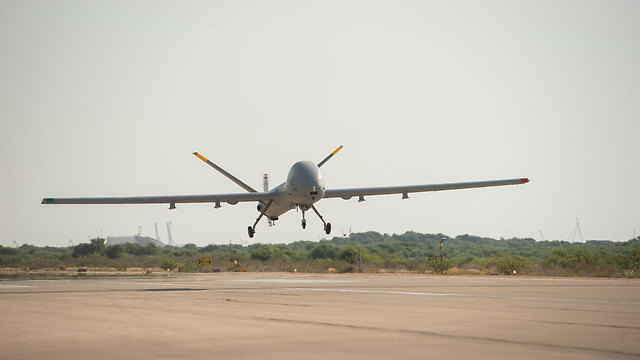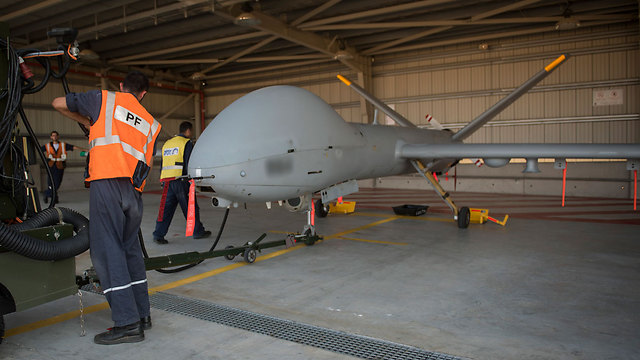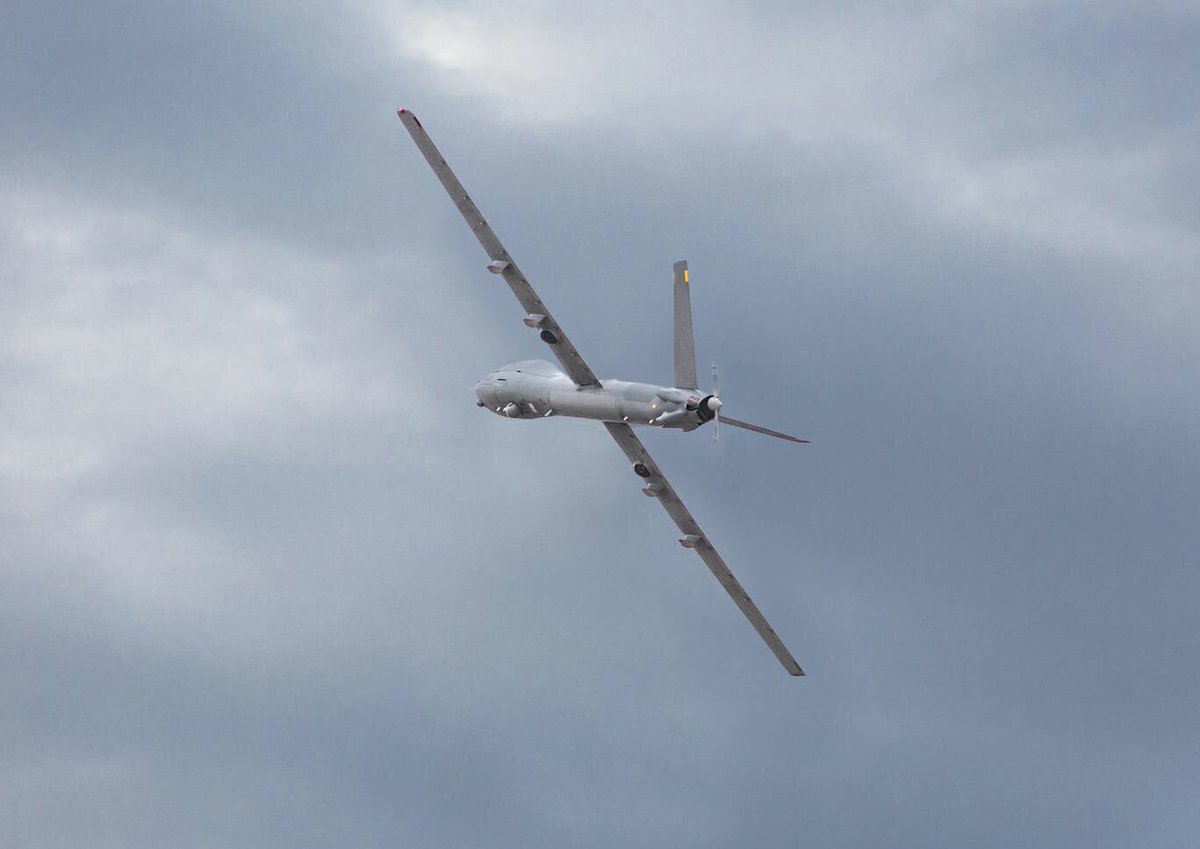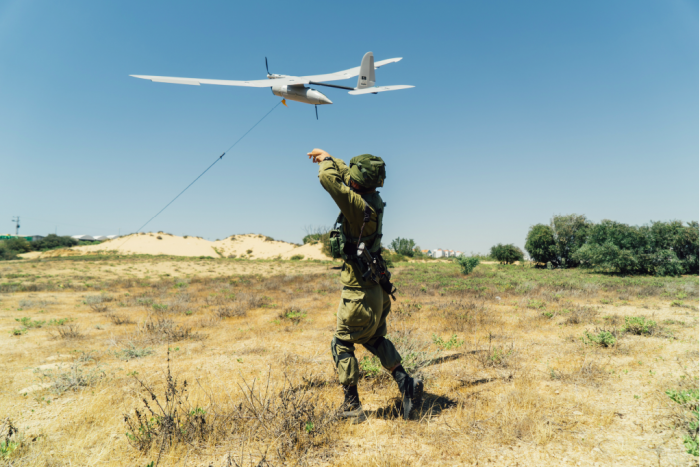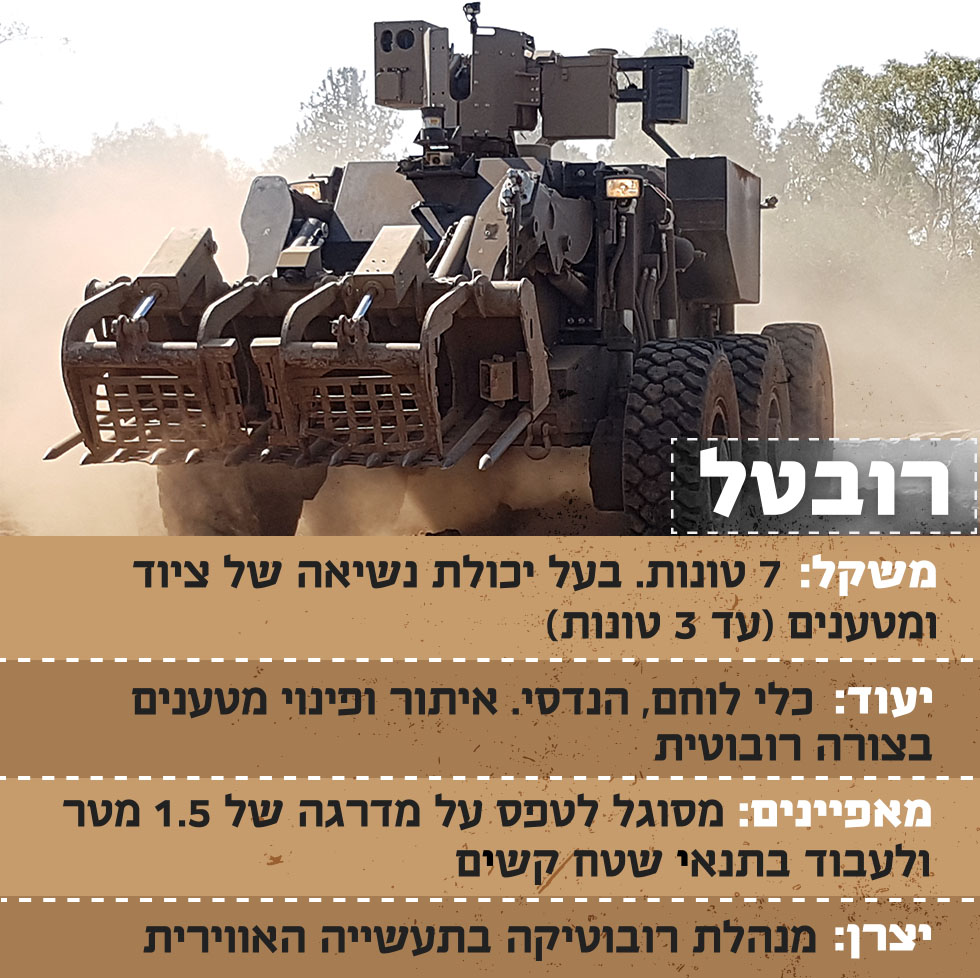THE AERIAL ARM OF THE IDF GROUND FORCES
In an era of interoperability and connectivity throughout the IDF, the aerial medium is an integral element of the combat doctrine of the various units of the IDF Ground Arm. Aerial platforms, from miniature drones (multicopters) to the Hermes-900 and Eitan (Heron-TP) UAVs, are the eyes and ears of the infantry, armored and artillery units
Dan Arkin | 27/09/2017

Send to a friend
A+A-Size
Share on
Share on
PHOTO: IDF
The State of Israel has a multiple-tier air-defense system that includes the Iron Dome, David's Sling, Arrow-I and Arrow-II systems. The forces of the IDF Ground Arm, the maneuvering elements, are similarly assisted by tiers of unmanned, remotely-piloted aerial platforms: drones (multicopters), Skylark-1 UAVs (IDF designation "Rokhev Shamayim", soon to be replaced by "Doher Shamayim"), Hermes-450 UAVs (soon to be replaced by the Hermes-900) and various other platforms.
Meet the air force of the 'green' (ground) forces – the air arm of the IDF Ground Arm HQ.
The IDF ground forces, from the company commander through the battalion commander, the brigade commander and the division commander, already benefit from "video & intelligence collection services" courtesy of both "green" UAVs (platforms operated by ground forces) and "blue" UAVs (platforms operated by the air force). In the context of brigade-level training exercises of the infantry, armored, artillery and engineering forces, during operations in the Judea and Samaria district, in pursuit and counterterrorism operations, in searches for wanted individuals, in joint operations of the ground forces in the various sectors and along the borders, field commanders are provided with a status intelligence picture from the payloads attached to the bellies of the UAVs. Video footage and still images of whatever is happening on the other side of the hill, on the battlefield or around the corner and on the roofs of houses in urban combat scenarios, images of wanted terrorists being pursued or of a specific window in a suspect house – data transmitted in real time, on line, from the payload camera to the operator's display screen, then interpreted and disseminated for intelligence purposes. When required, the data may be disseminated, at electronic speed, to the 'Pit' where the Chief of Staff is located.
The newest element of the "air arm of the 'green' forces" consists of the smallest, simplest and most 'civil' platforms – drones. These platforms have been operational with the surveillance units for almost a year, but the drone era is still regarded by the IDF Ground Arm HQ as a "project in its infancy" – despite the fact that drones have already produced operational results. The Drone Section at the IDF Ground Arm HQ set their objective as follows: "A drone to be made available to every company commander; drones to constitute an organic weapon system in every unit; the drone activity at the IDF Ground Arm HQ to be 'green' dominated."
Easy to Operate & Nearly Bug-Free
What are the advantages of drones? Firstly, they are nearly bug-free, owing to the extensive civilian experience in the operation of these platforms. Secondly, the platform is very simple to operate. The training course lasts only five days. In fact, a little over three days of the course are devoted to teaching the operator how to provide high-quality video input promptly and accurately. Thirdly, the take-off and landing are not an issue. Any surface may be used to land drones. They may be launched from the palm of the operator's hand and land practically anywhere.
Another major advantage – a drone can hover statically over a target, over a point of interest, or circle a target continuously – all according to the operator's instructions. Yet another important advantage – the platform is cheap and presents no maintenance problems, as millions are readily available worldwide.
The most common drone model currently used by the IDF ground forces is the DJI Phantom – the world's most common civilian drone. This drone model has four motors/rotors. The other basic model in use is the DJI Mavic, and the professional, advanced model used by the IDF surveillance units is the DJI Matrice, which features a payload with a day/night camera and extended endurance. The more advanced the drone model – the better the performance of the camera in its payload and the longer its endurance – just like the larger UAVs. For example, the Mavic drone can remain airborne for 22 minutes and the Matrice drone can remain airborne for 35 minutes.
How do these drones work on the battlefield? The camera produces video footage and the payload transmits the footage to the ground station, where the interpreter-operator, who uses a standard tablet computer, receives the data. The imagery is superimposed on a map and the information is disseminated to the intelligence users, wherever they may be located. The operators receive their training at the IDF School of Combat Collection/Surveillance, and this occupational specialty is already known as Drone Operator. Commanders receive additional training, which teaches them essentially how to make the most of the drone's potential and capabilities, what they can order the drone operators to do and the types of intelligence they can provide. Drones can fly at altitudes of a few hundreds of meters, but for operational purposes, they are restricted to a flight level of 100 meters. Drones are already operational with the IDF combat collection/surveillance units, and in the future, they will also be operational with the infantry battalions, although a few dozen drone systems already operate with various infantry units.
Going one rung up the platform size ladder to the "Rokhev Shamayim" (Skylark-1) UAV. This unit operates miniature unmanned vehicles and its troopers proudly wear the light-blue beret of the IDF Artillery Corps and don the winged horse unit badge. This unit is much in demand by new recruits wishing to join it. Some of its personnel consists of female troopers, and later this summer, a female officer, Lt. Col. Reut Rettig-Weiss, will be appointed as commander of the "Rokhev Shamayim" unit – the first appointment of a female commander in the unit's history. The range of missions assigned to the "air arm of the Artillery Corps" is expanding: a training exercise with the paratrooper brigade on the Golan Heights, routine security missions around the Gaza Strip, video support for searches for a wanted terrorist in the Judea and Samaria district. Field commanders will not make a move unless they have the support of the "Rokhev Shamayim" unit. A "Rokhev Shamayim" team has even traveled overseas recently, to participate in a tactical exercise conducted in Cyprus a few weeks ago. Additionally, a similar team traveled overseas secretly a few months ago on a special security mission.
By definition, the "Rokhev Shamayim" UAV layout provides a solution to the battalion level in the context of combat operations. This solution applies to the lower level of the airspace – below the Radar coverage and the clouds – important advantages of this platform. "We offer battalion commanders a high level of availability, as we not only operate under command of the battalion commander or brigade commander – but also aspire to be located physically close to him during the combat operation, so as to provide him with the video input he requires," they say at the unit. "Within minutes, we can get a platform airborne without an airstrip, day or night. Our mission range is extensive and the unit's 'services' are much in demand among IDF field commanders. Routine security operations, arrests of wanted terrorists in Jenin and Nablus, spotting underground tunnels in the Gaza Strip. We know how to identify tunnels being excavated or a plant that manufactures cast concrete elements for tunnels. We also monitor whatever takes place in Lebanon and Syria." The method of operation: when a "Rokhev Shamayim" team is deployed close to the field commander, the commander can see, with his own eyes, the video footage on the display screen. If he is away – the "Alle Yarok" (= Green Leaf) system is used. It receives the data from the platform in the air, transmits it to the operator's tablet and the data are disseminated immediately to the relevant field commander.
The UAVs used by the unit are made by Elbit Systems. The UAV model currently used by the "Rokhev Shamayim" unit is the Skylark-I, known in the unit as "Rokhev Shamayim 10". Following extensive trials, this platform will be updated and upgraded with regard to electronic warfare and maritime capabilities (cooperation with naval vessels and landing at sea). In the future, the unit will receive a new platform – the Skylark-III UAV, known in the unit as "Rokhev Shamayim 20" or "Doher Shamayim". This is a larger platform, capable of carrying multiple payloads, has an extended endurance of four to five hours. The new platform will be battery operated, capable of a higher flight level (about 3,000 feet) and an operational range of 40 to 50 kilometers. On this platform, the payload will be fitted to the belly, as in larger UAV models. The people of the unit explain that the operator teams will be trained to employ both UAV models simultaneously, to enhance their operational flexibility, with the UAV operators assisting one another in the field.
The "Rokhev Shamayim" unit makes a substantial contribution to the integration of female troopers in combat units. The unit absorbs and trains female operator teams on a regular basis, and the number of female operator assignments has increased.
Medium to High Altitude
Turning our attention now to a UAV that may be regarded as a fairly large platform: the Hermes-450 of the Green Squadron – a "green" unit admittedly, but nevertheless associated with the "blue" forces, whose platforms depart regularly from runways used by manned aircraft at airbases throughout the country. "We are an operational UAV unit of the Ground Arm, professionally subordinated to the IAF," they say at the squadron. "Our business is providing support to the ground forces through close cooperation. We are intimately associated with the 'green' forces – the maneuvering elements – and they are the elements being supported."
The Hermes-450 is regarded by Elbit Systems, the manufacturer, as a multi-mission tactical UAV. This UAV model has already logged thousands of flight hours with clients in Israel and overseas. The Hermes-450 can carry a diversified range of payloads, including electro-optical/infrared (EO/IR) sensors, laser pointers, ComInt (communications intelligence) and ElInt (electronic intelligence) pods. Its payload can weigh up to 180 kilograms. It has an endurance of 17 hours and a maximum flight level of 18,000 feet.
The Zik unit is a model of interoperability between the IDF Ground Arm and the IAF. Unit 5252 and similar squadrons share a common organizational infrastructure. This is clearly indicated in the personnel manning the unit: a UAV operator officer goes through an infantry officer course at the IDF officer training school and a UAV operator course at the IAF. The unit speaks two languages and operates within two cultural domains – the aerial ethos on the one hand and the unit's affiliation with the Ground Arm on the other hand – a unique situation for an IDF unit.
What does the Green Squadron actually do? "We translate the needs of the force being supported into the UAV language. We learn and train to help the force being supported, the maneuvering element. The 'blue' forces are a part of this interoperability. In the past, a deputy squadron commander never saw an infantry or tank battalion with his own eyes. Now they participate in joint workshops and training activities. We acknowledge the fact that the IAF is the regulator of the sky. We attempt to provide the Ground Arm with basic capabilities of utilizing the aerial medium all the way to battalion level. We want every battalion commander or brigade commander to know what he can obtain from our platform, the Hermes-450, and what types of intelligence it can provide him with. We recently conducted a training exercise around the Gaza Strip. They presented us with a simulation of a very complex situation. We collected intelligence, told the training force where the 'enemy' (the force simulating the enemy) was coming from. That is the type of information we picked up from the platforms. It is the multi-tier concept that is gradually spreading through the IDF: the 'Rokhev Shamayim' UAV provides the dimension of the lower level, the lower part of the airspace, and the Hermes-450 covers the intermediate level. In the future, we will assimilate the larger platform, the Hermes-900 UAV, which is to cover the higher level – the higher part of the airspace."
The Hermes-900 UAV is a full-size aircraft to all intents and purposes. It has a wingspan of 15 meters, a maximum flight level of 33,000 feet, an endurance of 40 hours and a 350 kg payload containing electro-optical cameras, a laser pointer and ComInt and ElInt pods. In preparation for the Paris Air Show held last June, Elbit Systems unveiled and advertised the new surveillance system for the Hermes-900 UAV – SkEye, whose unique feature is the ability to monitor an 80 square kilometer area cell, namely – a single platform can monitor an area cell of 80 square kilometers and transmit intelligence data picked up from that area cell. It monitors large areas and produces high-resolution imagery. The new system is intended primarily for operation over a city, during terrorist attacks, when escaping terrorists are being pursued through the streets and alleys of a city, as well as during natural disasters in urban areas. The monitor screen may be divided into ten different zones with each zone monitored separately, and the system also offers still imagery, recording and storage capabilities. This system can be fitted to the Hermes-450 UAVs as well.
The commander of the IDF Ground Arm HQ, Maj. Gen. Kobi Barak, wrote the following about the need for multidimensional warfare on the ground ('The Sky is No Longer the Limit', Issue 11-12 of 'Bein HaKtavim'): "The ground forces require independent aerial and air-defense capabilities in order to accomplish three objectives: miniature UAVs for spotting the enemy forces and their concealment infrastructures; development of new defensive capabilities that would enable the interception of aerial and steep-trajectory threats faced by the maneuvering forces, and promptly destroying the sources of enemy fire. The new aerial dimension of UAVs and drones should be utilized to maximum advantage, and robots and autonomous platforms should be used for such critical support missions as delivering combat logistic supplies to the forces." The commander of the IDF Ground Arm HQ stressed in his article the fact that "The enemy forces are decentralized and disappearing," and that the ground forces face a low-level threat. "In Iraq and Syria, the enemy forces employ UAVs and drones." He continues: "Hence the need for an air arm within the ground forces. The establishment of a fleet of miniature UAVs that would spot the enemy forces… The establishment of an extensive and diversified vertical (aerial) element within the brigades and battalions, the establishment of a group of autonomous airborne platforms operating as a coordinated 'flock', (providing) a connection between spotting the enemy forces and attacking them. A direct link between sensing and attacking."
The concepts described by the commander of the IDF Ground Arm HQ are being implemented by the Green Squadron. One of the troop commanders lists the unit's missions: "We are a UAV fleet. We maintain an operational alert state 24/7. We collect intelligence using our airborne platforms upon demand, direct the fire assets and protect the borders. We have platforms in the air at all times. The Green Squadron and its platforms are intended to provide support at the divisional level and above, and in extreme and irregular cases – at the brigade level and below. In fact, we provide support to the IDF regional commands, divisions, and brigades. We are currently in the process of taking delivery of the larger Hermes-900 UAVs.
"The operator team of a Hermes-900 UAV consists of 3 operators: the mission commander, in charge of flying the platform; a junior officer and an NCO whose occupational specialty is operating the system. We operate from a command and control trailer where we maintain contact with the platform and with the source of the video footage, the data and still images. Each trailer is fitted with a 'Masu'ah' system – a system for sharing information with the ground elements. The trailer and its occupants can, naturally, leapfrog from one location to another according to the requirements of the mission. Our technical section is in charge of platform serviceability, generators, and logistics.
"The operator team in the trailer monitors the imagery received from the platform's payload. For example, let's assume the mission is to find out whether someone is hiding inside a house. The surveillance equipment fitted to the platform can go down to the resolution of measuring the temperature emitted from a target. If we realize, for example, that the water pipes in the house being monitored are hot, it will be safe to assume that someone is at home, as hot water is being used. Conclusion: the house is occupied. This is vital information that could be critical for a ground force searching for wanted terrorists. We have a very special function that we perform in cooperation with the Artillery Corps: directing fire assets. Our platforms assist in the direction of artillery fire. We cooperate with the 'Rokhev Shamayim' unit and sometimes utilize the unique advantages of their smaller platforms for missions in the lower aerial medium. We cooperate with the attack helicopter squadrons of the IAF by spotting targets for them and directing the attack helicopters during the attack. We have a common language with the 'blue' forces. We are connected to the over-all operational plan, which includes both 'green' and 'blue' elements capable of speaking to one another, understanding the mission together and properly utilizing the relative advantage of each surveillance element – either airborne or ground-based."
In this era of interoperability and connectivity throughout the IDF, the aerial medium is an integral element of the combat doctrine of the various units of the IDF Ground Arm. Aerial platforms, from miniature drones to the Hermes-900 and Eitan (Heron-TP) UAVs, are the eyes and ears of the infantry, armored and artillery units, and even the naval elements are already sharing these resources. This is not plasma screen and fluorescent light warfare – our people are warfighter-operators deployed right next to the commanders of the maneuvering forces so as to provide them with the intelligence, video and audio information they require in order to make their decisions.
http://www.israeldefense.co.il/en/node/31263

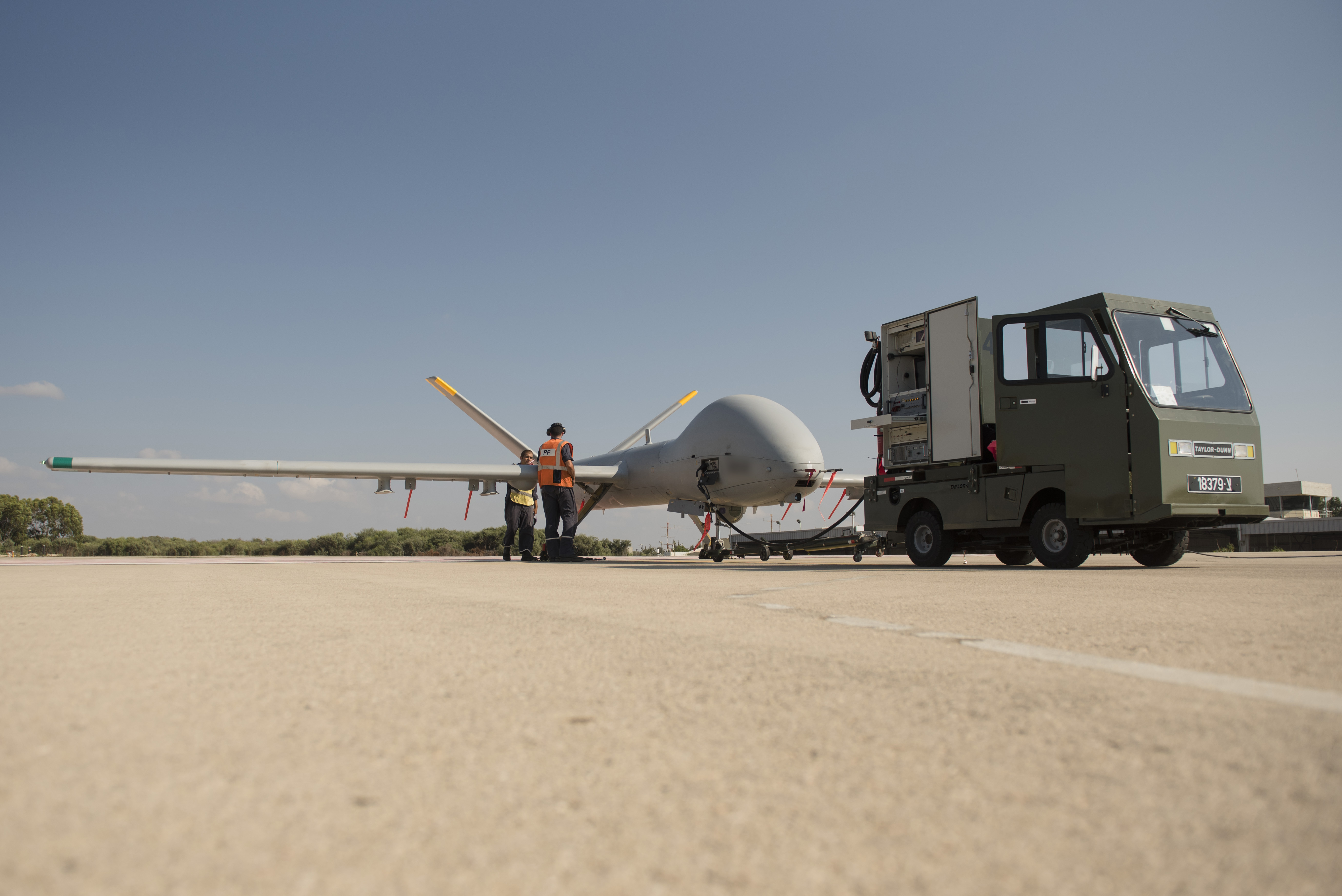 The new IDF "Cochav" drone, August 2017. (Credit: IDF Spokesperson's Unit)
The new IDF "Cochav" drone, August 2017. (Credit: IDF Spokesperson's Unit)